Riesz Potentials for Korteweg-de Vries Solitons and Sturm-Liouville Problems
Abstract
Riesz potentials (also called Riesz fractional derivatives) and their Hilbert transforms are computed for the Korteweg-de Vries soliton. They are expressed in terms of the full-range Hurwitz Zeta functions ζ+(s, a) and ζ−(s, a). It is proved that these Riesz potentials and their Hilbert transforms are linearly independent solutions of a Sturm-Liouville problem. Various new properties are established for this family of functions. The fact that the Wronskian of the system is positive leads to a new inequality for the Hurwitz Zeta functions.
1. Introduction
In recent years the theory of fractional derivatives and integrals called Fractional Calculus has been steadily gaining importance for applications. Ordinary and partial differential equations of fractional order have been widely used for modeling various processes in physics, chemistry, and engineering (see, e.g., [1–3] and the references therein). Recent theoretical developments shed new light on the interpretation and properties of fractional derivatives. Having written the latter in the form of Stieltjes integrals, Podlubny [4] found new physical and geometric interpretation of these structures relating them to inhomogeneity of time. Extension of the classical maximum principle to the case of a time-fractional diffusion equation appeared in the recent work of Luchko [5]. In the present paper we are concerned with Riesz fractional derivatives (also called Riesz potentials; see [6, page 88], and [7, page 117]) that are defined as fractional powers of the Laplacian Dα = (−Δ) α/2 with α ∈ ℝ. They are well known for their role in investigating the solvability of nonlinear partial differential equations, and the Korteweg-de Vries equation (KdV henceforth) in particular (see, e.g., [7–11] and the references therein). In the current work, Riesz potentials of KdV solitons are computed and their relation to ordinary differential equations is established.
Although there exists extensive literature on solitons, as far as we know, a study of their fractional properties is still missing. A preliminary investigation of Riesz potentials for a KdV soliton was carried out in [15]. In this paper the emphasis was put on the issue of whether solitons inherit fractional properties of fundamental solutions. Riesz potentials of a soliton, uα(X) = Dαu0(X), where u0(X) = 2sech2 X, X = x − 4t, and , and their Hilbert transforms, vα(X) = −Huα(X), were obtained in terms of the Hurwitz Zeta function of a complex argument, ζ(s, z) with s = 2 + α and z = 1/2 + iX/π. It was proved in [15] that the zero mean properties hold for both uα(X) and vα(X) with α > 0. This confirmed the predictions based on the properties of fundamental solutions of the linearized Cauchy problems.
The goal of the current paper is to go further and to study Riesz potentials of solitons as solutions of differential equations. We intend to show that these functions and their Hilbert transforms form linearly independent systems of solutions for a second-order ordinary differential equation in a self-adjoint form. This fact may be helpful in understanding the issue of using these structures as intrinsic mode functions in signal processing (see [16, 17] and the references therein), that is, in using Riesz potentials for expansions. In this context it is interesting to point out that the graphs of the functions uα(X) reveal a striking similarity to those of the Airy wavelets generated by the function Ai′(x)Ai′(−x) (see [18, page 34], and Figure 3 below).
The paper is organized as follows. In Section 2, we provide the necessary information on the special functions involved. Section 3 is devoted to the study of Riesz potentials for KdV solitons and their Hilbert transforms. In Section 3.1, the main properties of these functions are summarized. Sturm-Liouville problem (1.2) is derived in Section 3.2. Section 3.3 deals with the properties of the Wronskian W[uα, vα]. Zeros of the functions uα and vα are studied in Section 3.4. In Section 4, the inequality (1.4) is discussed.
2. Preliminaries
Denote by W[u, v] the Wronskian of the functions u(x) and v(x), that is, . For reader′s convenience, we present here [24, Theorem 5.3].
Theorem 2.1. Let p(t) > 0, q(t) be real valued and continuous for 0 ≤ t ≤ T. Let u and v be real valued solutions of the equation
In conclusion of this section, we would like to quote an interesting result concerning integrals over the real axis (see [25]).
Theorem 2.2. For any integrable function f(x) and g(x) = x − c2/x with c = const ∈ ℝ,
3. Fractional Derivatives of A KdV Soliton and Their Conjugates
In this section, we consider Riesz fractional derivatives of a KdV soliton and their Hilbert transforms and establish their properties. We notice that all the graphs were obtained with the Mathematica 6 software.
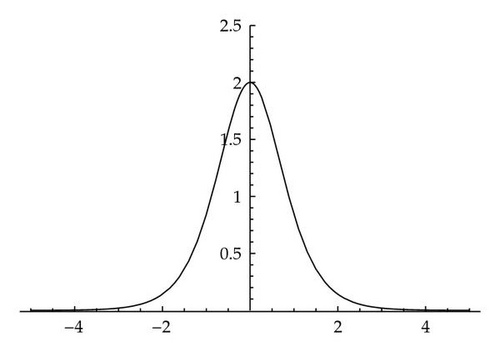
The next statement was proved in [15]. Using the functions (2.16) and (2.17), we rewrite it in a more convenient form.
Theorem 3.1. The functions uα(X) and vα(X) have the following representations for α > −1 and X ∈ ℝ:
3.1. Properties of the Functions uα and vα
In this subsection, we collect the properties of the functions uα and vα. Some of them were established in [15] and some are given for the first time as follows.
Properties of the Functions uα and vα
-
(1) The functions uα(X) and vα(X) satisfy the functional differential equations
-
(2) The functions uα(X) are even and the functions vα(X) are odd on ℝ (see [15] and Figures 1–4).
-
(3) The function uα(X) is periodic with the period 𝒳 = iπ. It follows from the periodicity of ζ+(s, a) with the unit period.
- (4)
For all α > 0 (see [15]),
- (5)
For all α > 0 and n ∈ ℕ,
- (6)
For all α > 0 and c ∈ ℝ,
Moreover,
- (7)
The functional sequence of Riesz potentials {uα(X)} converges pointwise to the soliton u0(X), and the functional sequence {vα(X)} converges pointwise to the conjugate soliton v0(X) for α → 0+ (see [15]). Notice that
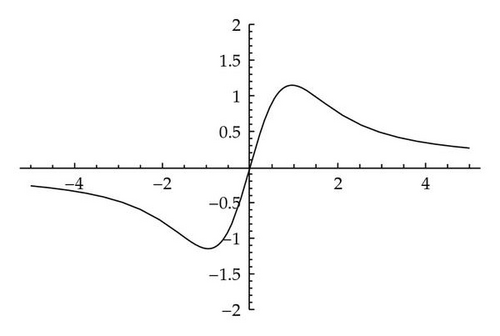

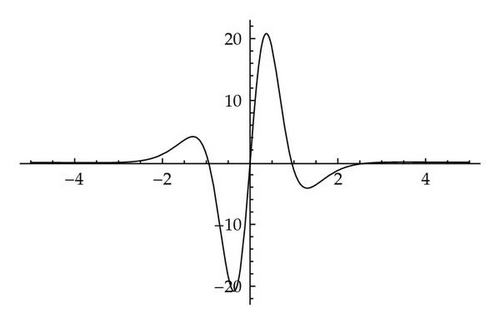
Remark 3.2. The conjugate soliton (3.12) is an algebraic solitary wave for extended KdV:
- (8)
For α ≥ 0, the functions uα and vα are the elements of L2(ℝ). Moreover, they are orthogonal in the principal value sense, namely, for all α1, α2 ≥ 0,
- (9)
At the point X = 0, one has for all α > −1
3.2. Sturm-Liouville Problem
The graph of the arctangent function Φα(X) is shown in Figure 5. Φα(X) conveniently serves as a zero counter for both functions: uα(X) and vα(X). It possesses zeros at the points where vα(X) has zeros and has jumps at the points where uα(X) has zeros.
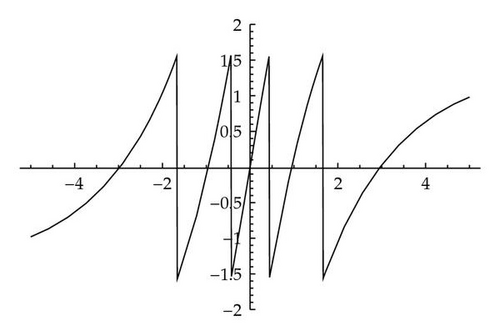
Remark 3.3. Observe that a general solution of (3.24) can be written in the form
3.3. Wronskian of uα and vα
Lemma 3.5. The following properties hold for the Wronskian Wα(X) for α > −1 and all x ∈ ℝ:
Proof. We start with (3.29). Taking into account relations in (3.3) and the fact that ∂X = H∘D, we can write
Three-dimensional graph of Wα(X) is given in Figure 6.
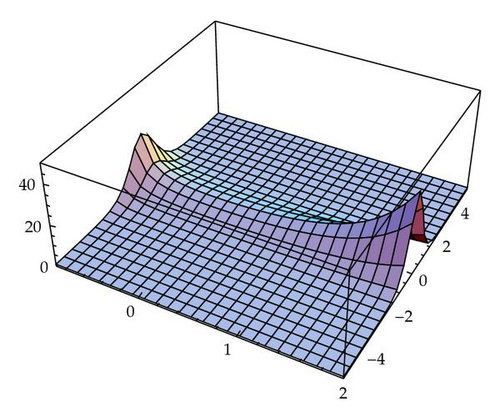
Remark 3.6. What does the positivity of the Wronskian yield for the soliton and its conjugate? For α = 0, (3.30) simplifies to read
3.4. Zeros of the Functions uα(X) and vα(X)
Theorem 3.7. Let Nα be the number of zeros of the function vα(X) on the interval [0, X0], where X0 < ∞. Then the following inequality holds:
Proof. Since we chose C = 1 in (3.22),
Theorem 3.8. The zeros of uα(X) separate and are separated by those of vα(X).
Proof. This follows from Sturm′s Separation Theorem (see [24], page 335).
4. Inequality for Hurwitz Zeta Functions
Here we discuss a new inequality for the Hurwitz Zeta functions which follows from Lemma 3.5. The next statement is a corollary of this lemma.
Corollary 4.1. For s > 1 and z = 1/2 + iX/π with X ∈ ℝ, the following inequality holds:
Proof. Dropping positive terms in front of the full-range Hurwitz Zeta functions in (3.4) and (3.5) and using (3.30) lead to
Remark 4.2. Setting and , we can rewrite (4.1) in the form
Remark 4.3. The proof of (4.1) becomes quite difficult when one approaches it from the point of view of special functions. For example, the use of integral representations (2.21) and (2.22) yields




